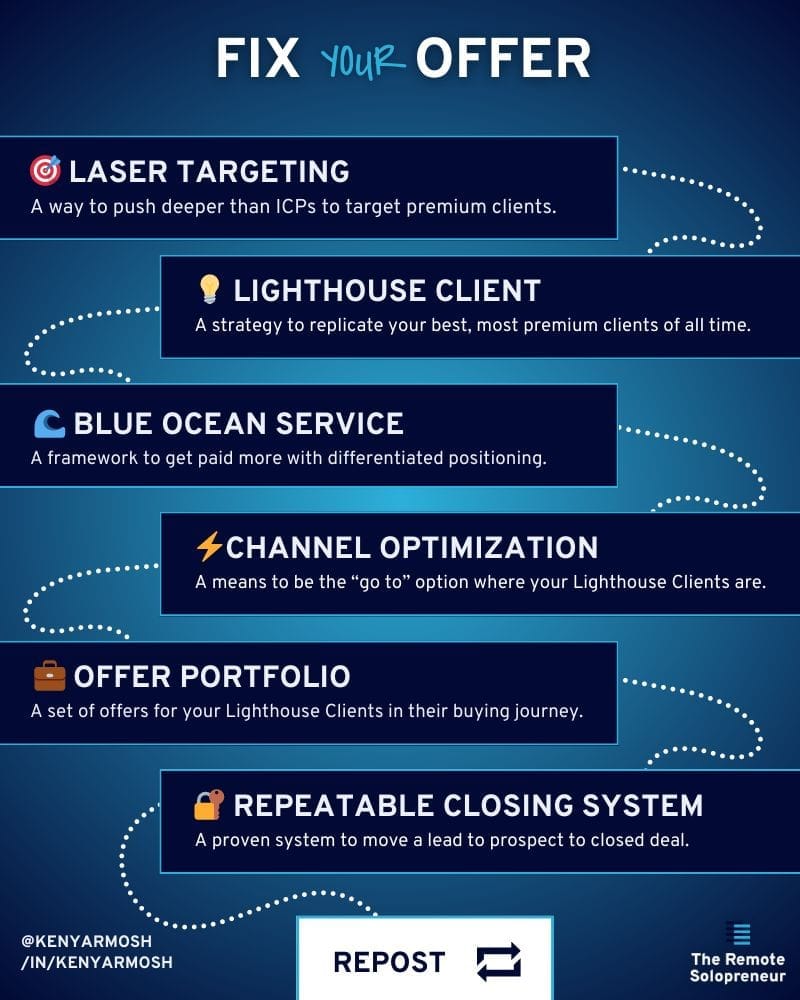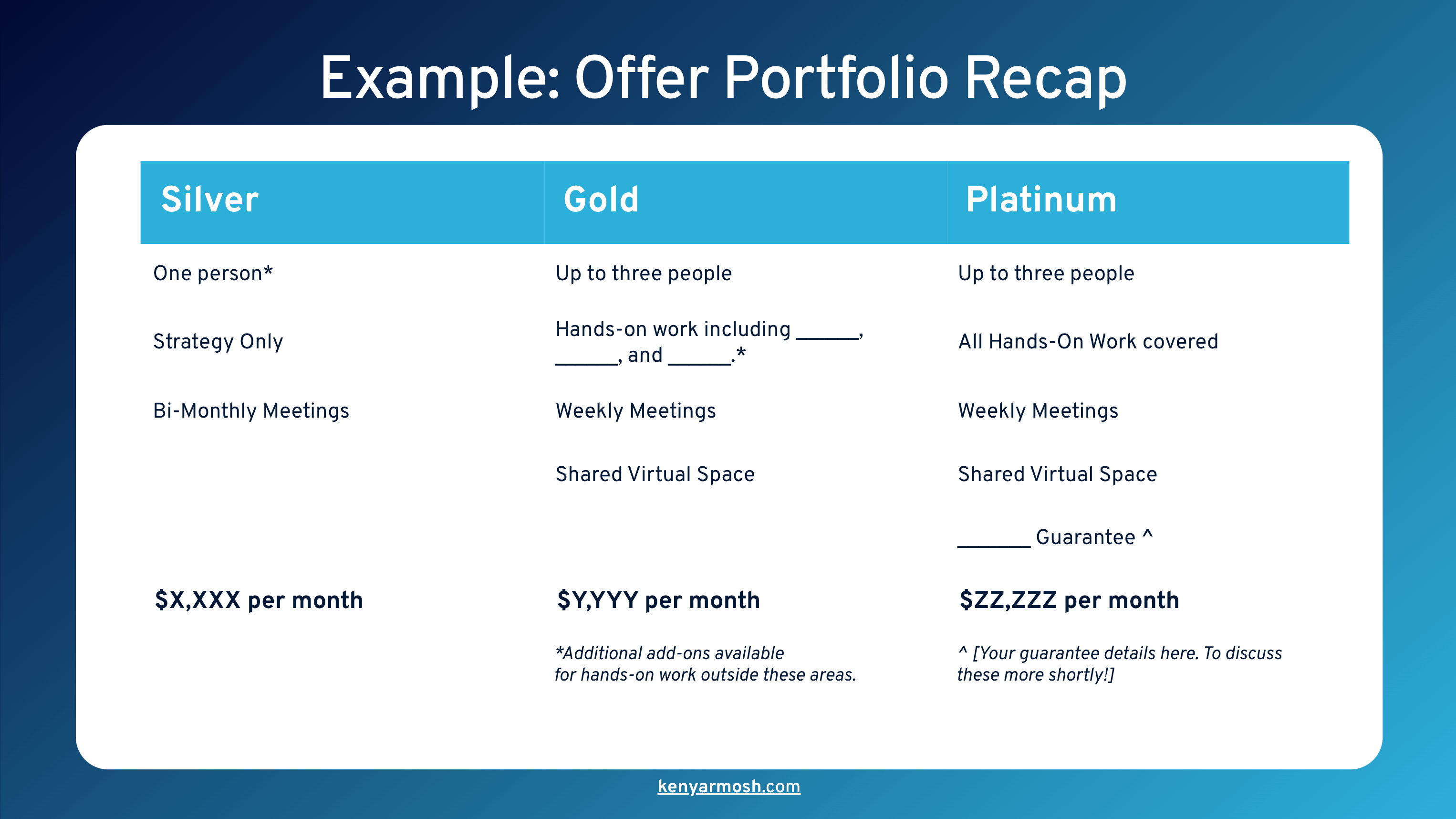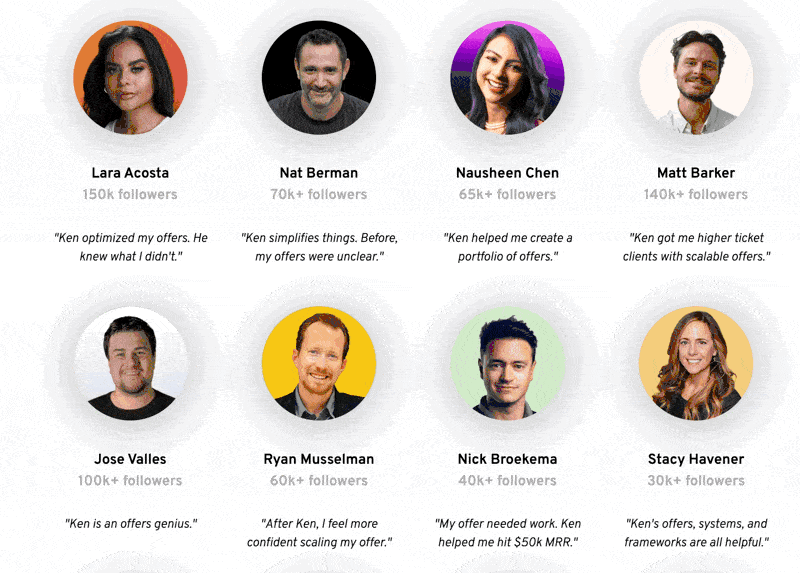🚀 TL;DR
- Most proposals ghost because offers are unfocused: clients need clear transformations, social proof, terms, and visible distribution — not a long list of deliverables.
- Nine essential elements turn forgettable offers into irresistible ones: Laser Targeting, Lighthouse Clients, Blue Ocean Services differentiation, Channel Optimization, Offer Portfolio, Repeatable Closing System, clear transformations, social proof, and clear terms & revenue model
- Design offers around a single, urgent client problem, lead with outcome (not process), systematize delivery, and provide evidence/terms that reduce buyer risk.
- When these elements align, you shorten sales cycles, reduce scope creep, command premium pricing, and attract repeat/referral business — the whole stack compounds.
- Start by auditing which 2–3 elements are weakest today, then run rapid tests (MVP launches) to validate improvements before scaling widely.
You're speaking with a prospect. They seem enthusiastic about your approach. Then you send your proposal, and suddenly—radio silence. This pattern repeats with different prospects, leaving you wondering what's wrong with your offers.
I've been there. After scaling multiple seven-figure businesses, I've learned that most service providers don't have a marketing problem. They have offer and sales problems.
Your expertise alone doesn't sell. The way you package that expertise determines whether clients say yes or ghost you after the proposal stage.
I often see the same mistake when I work with consultants and service providers. They focus on deliverables (strategy sessions, reports, implementation) instead of outcomes. They list everything they'll do without clearly articulating the transformation clients will experience.
This guide will show you the 9 essential elements that transform a forgettable service offer into irresistible.

1. Laser Targeting
Your offer isn't for "everyone interested in marketing." It's not even for "small businesses." Those broad categories create weak offers that try to please everyone and end up impressing no one.
Laser targeting means going deeper than generic ideal client profiles. It's about being ruthlessly specific about who you serve.
When I scaled past seven figures as a solopreneur, I focused exclusively on helping established service-based solopreneurs scale without hiring. This clarity made everything else easier—my marketing, sales, and delivery became dramatically more efficient than when I worked with various business types.
A strong offer speaks directly to one person with one problem, not to vague market segments.
The temptation to keep your targeting broad comes from fear that narrowing down means missing opportunities. The opposite is true.
When you target everyone, you resonate with no one. When you target specifically, you become the obvious choice for your ideal client.
Define your Lighthouse Client so that it's easier to recognize which opportunities align with your business goals.
2. Lighthouse Clients
Building on laser targeting, your offer must be explicitly designed to attract more of your best clients—what I call Lighthouse Clients.
Many consultants fall into the trap of accepting any client who can pay, then wonder why they're stuck in delivery hell with demanding, low-paying projects. This happens because their offers don't clearly signal who they're designed for.
For each opportunity, ask yourself:
- Does this client match my LC?
- Will this project use my core expertise?
- Can I deliver exceptional results within my existing systems?
- Is the budget aligned with my target pricing?
- Does this work support my long-term business direction?
If an opportunity doesn't meet at least 4 out of 5 criteria, it will distract you from scaling. The wrong clients cost more than the revenue they bring in. Every minute spent on a poor-fit client is a minute not spent finding and serving your Lighthouse Clients.
3. Blue Ocean Service
The third element is differentiated positioning that lets you charge premium rates. This is what I call your Blue Ocean Service—positioning that makes competition irrelevant.
Most service providers position themselves in crowded, competitive spaces. These Red Ocean positions force you to compete on price because clients can't quickly identify what makes you different.
You have no leverage if your offer looks like everyone else's. The highest-earning founders are the ones who design offers with clear transformation, not laundry lists of deliverables.
A Blue Ocean Service emerges when you find the unique intersection of your genuine expertise, market needs, with willing buyers, and areas you enjoy working in. This becomes the foundation of your positioning.

Instead of being a generic "marketing consultant," you might position yourself as "the email sequence specialist who helps SaaS companies improve trial-to-paid conversion rates."
When I scaled past seven figures as a solopreneur, I focused exclusively on helping established service-based solopreneurs scale without hiring. This clarity in positioning made my marketing, sales, and delivery much more efficient than when I worked with various business types.
Your offer should communicate this differentiation clearly.
For example: "I help independent financial advisors double their client acquisition through relationship-based content strategies without spending on paid ads."
4. Channel Optimization
Even the best offers fail if they're invisible. The fourth essential element is a distribution strategy that positions you in the right channels where your Lighthouse Clients spend their attention.
Many service providers make a critical mistake: they build an offer, then frantically try to find people to buy it. Successful offers work in reverse—they're designed with distribution already figured out.
I see this repeatedly with clients who come to me frustrated about marketing. They've created solid services but have no systematic approach to being visible where their ideal clients are looking for solutions.
Your offer should include strategic visibility in channels your ideal clients already trust. This might include specific LinkedIn groups, industry publications, podcasts, or communities where your expertise can shine.
Choose to specialize in a specific client type (industry, size, stage) or a particular problem you solve exceptionally well. This focus makes your channel strategy more effective and affordable.
Being everywhere is expensive and ineffective. Being highly visible in 2-3 targeted channels creates momentum.
5. Offer Portfolio
The fifth element is a strategic set of offers that serve different stages of your Lighthouse Client's buying journey.
Having only one offer creates two problems: it limits your lifetime client value and forces you to make that offer work for everyone. Instead, create a clear progression path for clients.
Most solopreneurs approach this backward. They create random services without considering how they connect. This results in confused clients and missed revenue opportunities.
Once you've simplified your core service offering, consider creating 2-3 tiers that serve different client needs. This gives options without overcomplicating your business.
A good structure includes:
- Intro: An accessible, focused solution for specific problems
- Core: Your flagship comprehensive solution
- Premium: Everything plus additional support or exclusive features

This approach allows you to serve different budget levels while maintaining operational simplicity. It also creates a natural ascension path for clients to continue working with you.
Instead of offering many services at once, create a clear progression path for clients. Start with a focused entry point and then provide logical next steps as clients see results.
6. Repeatable Closing System
The sixth element is a structured, proven system to move leads from interested prospects to closed deals. Too many service providers reinvent their sales approach with every potential client, creating inconsistency and missed opportunities.
When consultants complain about inconsistent sales, I typically find they're treating each prospect conversation as a unique event without a clear framework or process. This approach makes scaling impossible.
A repeatable closing system built into your offer establishes clear next steps after initial interest, a structured conversation framework, consistent proposal templates, and follow-up sequences that prevent leads from disappearing.
Never overservice a client to make an offer look better. An irresistible offer is one where the client immediately sees the ROI from the specific outcome you promised—not endless add-ons.
Your offer should include a clear path to purchase that removes uncertainty for both you and your prospects. They should know exactly what happens after they express interest.
7. Clear transformations
The seventh element is positioning your offer around outcomes, not "services delivered." This shift lets you raise prices and escape commoditization.
Low-value offers list projects and tasks—strategy sessions, support hours, weekly calls, and custom reports.
High-converting offers promise measurable transformations—generate qualified leads, reduce acquisition costs, cut operational overhead, and close premium clients within a specific timeframe.
Notice the difference? The first group focuses on what you do. The second focuses on what clients get.
There are 2 types of "offer experts" on LinkedIn:
- Those who tell you to add more bells & whistles
- Those who tell you to focus on a single clear promise.
Only one of these is profitable long-term.
Your offer should prominently feature the transformation clients will experience. This isn't about making wild promises—it's about clearly articulating the change your service creates.
When a client can visualize the before-and-after state your offer provides, price becomes secondary to the value of that transformation. They're no longer buying your time or deliverables—they're buying the outcome.
8. Social proof
The eighth element is evidence and guarantees that lowers the perceived risk of investing in your service.
Clients buy confidence even more than they buy services. They need reassurance that your approach works for businesses like theirs and that their investment is protected.
Many service providers mistakenly believe they can't offer guarantees. While you can't guarantee specific results that depend on client participation, you can guarantee your process, response time, or satisfaction with deliverables.
Your offer should proactively address the question: "How do I know this will work?" This doesn't require outlandish promises—just honest evidence and reasonable assurances.
The most effective forms of proof are case studies from similar clients, specific metrics and results achieved, third-party validation, and process guarantees that focus on your delivery, not client outcomes.

Integrate social proof directly into your offer, not as an afterthought. When prospects see evidence that people like them have achieved the results you promise, resistance melts away. Lighthouse Clients who guide your business decisions become your most powerful testimonials.
9. Clear terms and revenue model
An offer isn't just about what's delivered—it's about how it sustains your business.
Most service providers undermine their offers with vague terms, creating misalignment and eventual resentment. Clear terms set the foundation for successful client relationships.
Your offer should establish payment terms that support your cash flow, service boundaries that prevent scope creep, intellectual property rights for deliverables, communication expectations, and resolution processes.
I structure most of my offers with retainer-based pricing with premium client value (>$5k/mo) and ensure no client exceeds 20% of my total revenue. This creates predictability for both my business and my clients.
Your service contract should protect both parties. This isn't just legal protection—it's about setting clear expectations that prevent misunderstandings and disappointment.
Include elements like confidentiality and termination clauses that specify what happens if either party needs to end the relationship early. These might seem formal, but they actually create comfort for clients who know exactly what to expect.
A strong revenue model ensures your service is sustainable in the long term. If your pricing doesn't support your business, you'll eventually resent clients or deliver subpar work—neither of which leads to referrals or renewals.
Build scalable service offers to experience true success
These nine elements don't exist in isolation. They form an interconnected system where each reinforces the others.
Your laser targeting informs your Lighthouse Client strategy, shapes your Blue Ocean positioning, determines your channel optimization, and so on. When all elements align, your offer becomes greater than the sum of its parts.
I've helped hundreds of service providers implement this framework across various industries. The results are consistent: higher close rates, premium pricing, reduced sales friction, and greater client satisfaction.
The work begins with an honest assessment of your current offer. How many of these elements are missing or underdeveloped? Where are the weak links in your offer chain?
Most service providers are only 2-3 elements away from a breakthrough. The missing pieces usually hide in plain sight—clear outcomes, better positioning, or stronger proof elements.
Your expertise deserves an offer worthy of it. Not a generic template, but a carefully crafted invitation that connects your unique value to clients who need it most.
Your bridge to better clients is waiting to be built.

